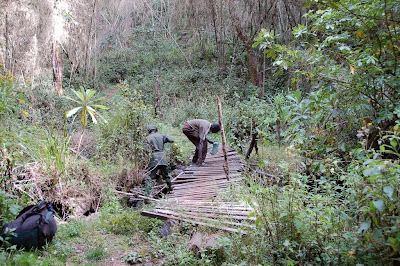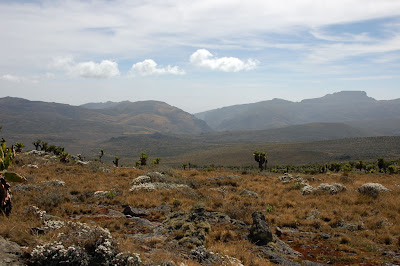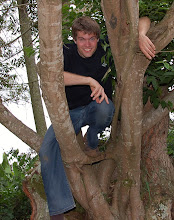


 Picture one and two show the main office of Posta Uganda on a day with very little traffic on Kampala Road.Pictures three and four above show the Castle at one end of Karl Johan street, built on the instructions of Karl Johan.
Picture one and two show the main office of Posta Uganda on a day with very little traffic on Kampala Road.Pictures three and four above show the Castle at one end of Karl Johan street, built on the instructions of Karl Johan. This catchy name (of Posta Uganda) belongs to the ugandan post service.I have had the pleasure of using their services a couple of times. Here I want to tell about one time when I received a parcel from a country far away in northern hemisphere of the world.
One sunny morning when I walked in to the FOCUS office I was stopped by the always smiling receptionist. She handed over one slip from Posta Uganda which stated that I could pick up a big parcel from the main post office. Previously I have travelled to Wandegeya Post Office to pick up a small parcel. Out of curiosity I asked if she knew why I this time had to go to the main post office in the city centre instead of using the local post office in Wandegeya. The answer I got was that it depended on the size of the parcel. Letters and small parcels could be retrieved in the local post office while for larger parcels and some other services you had to go to the main post office. I found this to be a curious way of delivering postal services but said nothing as I knew very well that there are other strange things that happen in my own country.
A few days later I found time to travel to the city center in order to collect the parcel. Posta Ugandas main office is located on Kampala Road which is the main road in the capital and compareable to Karl Johan. Here I guess it's time with a simple explanation. The name Karl Johan refers both to a late king and to the main street in the capital of the country from where I recieved my parcel. This street does of course have it's name from this king. The lifestory of this king is rather fascinating. He was born in Pau in France the 26th of January 1763 where his father was a french official. His mother was Jeanne de Saint-Vincent and the name of his father was Jean Henri Bernadotte. The future king was baptised Jean-Baptiste Bernadotte. During the time after the french revolution he served in the french army and advansed rapidly until he became general. Though he didn't help Napoleon Bonaparte climb to power he continued his work in the French army during the time of the French Empire under Bonaparte. In the beginning the 19th century the swedish government was in desparate search for an adequate heir to the throne. A swedish official took the case in his own hands and offered the throne to Bernadotte. This didn't fall in favour home in Sweden at first and the daring swedish official was thrown into prison. Later the swedish government rethought the whole thing and decided to elect Bernadotte as King of Sweden on 21 August 1810. As King of Sweeden he took the name of Karl Johan and he would later participate in the alliance which ended the rule of his former «boss» Napoleon. During the tumultous and chaotic times after the end of the Napoleonic wars the neighbouring nation of Sweeden tried to free itself from danish rule. Sweden had been promised this country as a part of the peace treaty of Kiel. Out of this a conflict between the swedish government and representatives of the government of it's neighbouring country arose. Escalation of the conflict continued until war emerged. None of the fighting parties were interested in a long lasting and full scale conflict and so a peace agreement was reached late in the autumn. In the end the two countries were joined in a personal union where the independent struggeling nation were allowed to keep it own newly written constitution. These events in distant time full of chaos, changes in society and war which is so much different from todays world made the prelude to that the house of Bernadotte still regins in Sweden and that the main street in another distant country in the northern hemisphere is named after the ruling name of a swedish monarch in the 19th century born in France and baptised with another name than his ruling name of Karl Johan.
Because the main office of Posta Uganda have such a posh adress it's quite easy to find. When I entered through the main door I belived that this would be an easy task as I had been inside before to post a few letters which were destined for the very same country in the far north. Alas how wrong I was. It would take me much more time and talking to much more people than I could ever have imagined before entering throuhgh the doors of Posta Uganda. As I walked down the corridor inside I started to think that I could only remember counters which was ment for sending letters and buying stams, so I decided to approach the information desk and ask where I could collect my parcel. To live up to the Ugandan cultural code of friendlieness I first greeted politely and a few polite remarks was exchanged between me and the postal staff behind the desk. When Good morning, How are you. I am fine thank you and such phrases were completed, I showed my parcel slip and asked where I could collect it. At this moment I didn't know it, but this person was only the first out of several I would have to interact with and be friendly with before I could retrieve my parcel. I will therefore name these people with increasing numbers as the story unfolds and more people comes into it. «This is not the place to retrieve parcels. You need to go out and go to the parcels office.», the answer sounded. No need to tell that I was rather disappointed. I continued to ask where I could find the parcels office. «Walk around the building and go up the stairs to the parcels office.» was the answer, so I thanked and walked out. On the other side of the building it looked like a proper backyard in a big city and it also was on staircase leading up. Climbing up was easy and at the top it was only one door leading into a corridor with a very stern looking armed guard gazing out on me. Armed guards are relatively common here in Uganda though most of them look relatively friendly, while this one looked on me in a way that told me that I was clearly in a wrong place. I still felt that I had followed the instructions and I didn't know any other place to go to find my parcel. I therefore initiated the greating procedure and when he had replied in a friendly but very brief way I continued with asking where I could find the parcel office. He told me to walk down again and I would there find the entrance to the corridor where I could find the Parcels office. Thanking for the advise I walked down again thinking that it requiered more exploration than I would have believed to recieve my parcel. At the bottom of the staircase I found myself on ground level, though I realised that it was higher up than ground level on the other side of the building. And I remembered a closed staircase inside the building and thought that the woman at the information desk might have referred to that one when she talked about going upstairs. Looking around I found the entrance to a corridor and walked in. On one side it was partly open to the backyard and since it was no artificial light in the corridor it was a kind of shadowy twillight in the corridor. On my other side it was several doors some where closed, others led into empty rooms and other again led into a kind of darkness inside. None of them had a sign telling me what they led to. I therefore continued down the corridor thinking that if I didn't find a sign for the parcels office I would have to test out every door I had walked past. Near the end of the corridor I found an opening with a sign above that said Parcel office, so I entered. Inside was a huge room, it was aproximately 4-5 meters broad and around 10 meters long. Along one of the long walls it ran one continous desk from one end of the room to another. The entrance divided the room into two halves and on to the one side there was a smaller desk and on the other it was a bench to sit on. Inside the room it was five other people, two of them was clearly cusomers which were helped by two of the post personal in the room. Hanging down from the roof it was also two signs. One above the small desk which said recovering and another above one end of the long desk which said delivering. I belived that the recovering desk must be the place to get my parcel so I waited since it was already another customer at the desk. As I waited and studied the room the woman behind the long desk beneath the delivering sign shouted to me «Do you need help», so I walked over and was meet with the normal ugandan friendlieness. Once I had shown her my parcel slip and explained my quest to retrieve my parcel she asked if I had any official legetimation and then she could help me. I therefore showed her my driver liscence. After studying it for a while she looked content and told me that she would go to find my parcel and that I could sit down on the bench and wait. Then she quickly disapppeard into the blackness of the opening behind here. More than 10 minutes passed by and I only hoped that I would sometime see my driver liscence, my parcel slip again since she had disapperead with them. At last she reappeard with a big box in her hands and called me over. From somewhere behind the desk she produced a large book where she started to fill in details about my parcel and also from my drivers liscence. After a while she asked my what the referance number of my identificaton was. And she added on an extra question about which language it was. This initiatied a long conversation about Norway, that the language is actually Norwegian, how long I had been in Uganda and what I am doing here etc, etc. Of course I also explained where she could find the reference number of my drivers liscence. When she had heard enogh she asked me to sign her book to confirm the information about my parcel and my identity. While signing the book I though that it was good that they took the job of handing out parcels seriously and I was happily thinking about returning home to unpack the parcel. Alas for had I only known that I would still spend a long time in the parcel offic. When the book was signed she gave me a reciept for recieving the parcel and told me that I could continue to the other end of the desk. So I took the parcel, the parcel slip, the reciept for parcel recieving and my drivers liscence and walked towards the other end of the room where I could see a man waiting. I approached him and went through the usual routine of friendly greetings and gave him all my papers excluding my driver liscence and my parcel. He then started seraching energetically through a large pile of small white papers. A few minutes later he stopped searcing and started reading and it then became that he had found the original part of my yellow parcel slip. These he effectively stamped before he started to contemplate upon the writing on the declaration slip on my parcel. Several minutes later he asked me what it sadi here and which language it was as he pointed to the contents box on the declaration slip. I first of all explained that it was written in Norwegian and that the parcel was sent from Norway in northern Europe before I translated what it said. We then ended up having a small conversation about what these contens was. And it became nesescarry with a small speech about Norway, what I did in Uganda and how I found the country. In the end he just told me that he would need to talk with his boss and asked me to wait for him and then he disapperead for a while. He reapperad together with a woman who walked over to my parcel, studied the parcel slip for a while before she turned to me and started to exchange the requiered friendly small talk. She then asked me what it said in the contents box and which language it was. To this new and surprising question I tried to give as clear and short answer as possible. After a few more specific questions she thanked me for my answer, turned towards the man and told him something I didn't hear before she left. Alone with the man again I was asked to sign both the copy and the original and the copy of my parcel slip to confirm that I had recieved the parcel in unharmed condition. By now I had experienced so much fun in the parcel office that I wasn't much surprised when I was given the three differen pices of paper and my parcel and asked to pay a visit to another desk in the room. This desk was occupied so I had to wait for a while before I could encounter it. First we went through a number of friendly greetings. Another big book then emerged from behind the desk and the woman started to write down details from my parcel and from the papers I was bringing with me. She then asked for official legetimation and so I gave her my drivers liscence and this time it wasn't surprising that I needed to explain what the reference number was, which language it was and even more. Once all detailes was filed in the big book she asked me to sign, write the date and pay 3000 schillings. More and more fascinated by the byroucracy of the Ugandan post service as I was thinking about what could possibly come next. To my my surprise and delight she told me that I could now leave.
Totally I must have spent nearly two hours to pick up my parcel so I nearly danced of joy as I left the building. Thinking about the whole event I realised that I had talked with six different people, used 3000 schillings, explained a lot about myself, Norway, Norwegian and given some comments about how I find life in uganda in order to be able to pick up one parcel. When it comes to time it took me many times as long time as I had believed. Looking back I find it to be a funny and intersting meeting with a foreign byroucracy and the end result was also good. I finally recieved a parcel with the suspicous content of norwegian chocolate, norwegian comics, a few socs, a torch and a fes other harmless items. All of them have brought much joy into my life and to other people of native or foreign origing in Uganda.















